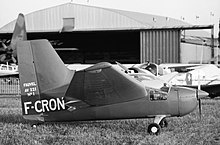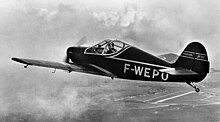Charles Fauvel
Charles Fauvel (born December 31, 1904 in Angers , † September 10, 1979 in Italy ) was a French aircraft designer.
Life
Charles Fauvel was drawn to aviation from an early age. From 1913 he built model airplanes and took part in model flying competitions. In 1923 he received a scholarship for flight training and acquired a pilot's license. He then entered the French Air Force Academy. In 1925 he flew his first competition in Vauville , Manche. In the same year, during his military service in Chateauroux, he met Pierre Massenet and co-founded the aviation club at the Military Academy.
Charles Fauvel was best known for his flying wing aircraft designs . In 1925 he designed his first flying wing AV.1, followed by other variants AV.2 up to the AV.10, which flew for the first time in 1937. The type designation AV stands for Aile Volante (flying wing).
Due to the Second World War , its developments and work were interrupted. When Germany invaded France in 1940, Charles Fauvel was assigned to Morocco to command an air squadron . After the armistice back in France, Fauvel was appointed head of the Air Force Center in Avignon . In May 1945 he became head of the aeronautical facility in Castelnaudary and began working with the “Société Aéronautique du Rhône” to manufacture his developed AV.17 based on the AV.3 model. A characteristic feature of all Fauvel designs up to AV.17 was a single trapezoidal wing with a strong taper.
Success models
Numerically, the AV.17 was followed by the two-seater AV.22 . Here the seats were installed in tandem. The motor gliders AV.221 and AV.222, which had seats next to each other, were derived from this machine. The AV.222 had a central wheel with support wheels, while some AV.221 received a bipod.
Fauvel's greatest commercial success, however, was the flying wing glider Fauvel AV.36 , which was first flown in 1951 and then used in over 16 countries around the world. With the AV.36, Fauvel deviated for the first time from the single trapezoidal wing and used a rectangular wing center piece.
From 1955 the AV.36 was also built in Germany. In 1954, Charles Fauvel founded the company "Survol" in Cannes in the south of France to promote flying wing construction.
In 1956 he introduced the AV.22. Six machines were built from this two-seater version. In 1971 Charles Fauvel decided, in addition to the commercial production of his flying wing aircraft, also to manufacture simpler versions for amateur aircraft builders.
The company Survol produced kits and drawings under the type designation AV.361 (sailor), AV.45 / AV.451 (motor glider based on the AV.361) and AV.60 (motorized airplane). How many Fauvel machines were manufactured worldwide is not exactly proven. There is, however, a photo of an AV.361 (F-CRQX) with the serial number 222 or 232 painted on it. It can be assumed that this refers to the entire AV.36 / 361 series, including the kits supplied and the German license builds.
Fauvel's last creation was the AV.451, which, compared to the AV.45, had a span that was enlarged to 15 m and was equipped with a Wortmann FX 66-H-159 laminar profile. This machine first flew in 1978 and achieved a glide ratio of 32. The cockpit had been enlarged and the canopy came from a Grob G102 Standard Astir CS77. A version in plastic construction (AV.48) was no longer built.
The AV.451 was (apart from the Horten IVb from 1944) until 1988 (when the SB13 flew) the only attempt to equip a tailless glider with a laminar profile. A direct comparison of the performance of the flying wing with contemporary normal gliders was not carried out until 2016, when Jim Marske (the only other manufacturer of flying wing sailplanes in the world) presented his 15-meter board-only wing Pioneer 4, which, according to the manufacturer Kollman Composites, has a glide ratio of 48.
Fauvel also held a number of world records, including a high-altitude and endurance flight in 1929 for aircraft under 400 kg total mass.
He died on September 10, 1979 at the controls of his aircraft CAB GY-30 Supercab while crossing the Alps north of Genoa in Italy.
On May 23, 2000 the asteroid (11849) Fauvel was named after him.
Others
In 1996 the Alpaero company brought out the ultra-light motor glider "Choucas" by the designer Claude Noin as a kit airplane. The design corresponds to that of a reduced AV 221. The two-seater machine has a length of 5.35 m and a span of 14.35 m. The wing profile is the Fauvel F2 with 17% thickness. In the meantime about 14 "Choucas" have been delivered.
Web links
- Biography Charles Fauvel on nurflugel.com (English)
- Photo of the AV.22 two-seater
- AV.60 sectional drawing
- Video AV36 in flight
- Video AV36 in flight
- Video AV 22 in flight
- Video AV222 in flight
Individual evidence
- ↑ Fauvel AV-36 CR. Deutsches Museum - Flugwerft Schleissheim, accessed on January 18, 2014 .
| personal data | |
|---|---|
| SURNAME | Fauvel, Charles |
| BRIEF DESCRIPTION | French aircraft designer |
| DATE OF BIRTH | December 31, 1904 |
| PLACE OF BIRTH | Angers |
| DATE OF DEATH | September 10, 1979 |
| Place of death | Italy |










